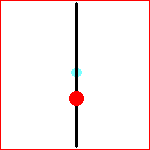
longest possible clock hands
The hour and minute hands of a watch or clock are distinguishable by their lengths. And we are used to reading the time with a quick glance at the angle between these different length hands.But because the hour hand must be shorter than the minute hand, the combined total length of the hands must be less than 100% of the diameter of the face. Is there a way to retain the familiar features of the hands (hour is shorter, regular time angles) and use the longest possible hands? Specifically, can the combined lengths of the minute and hour hand be 100% of the diameter of the face?
Yes. This is done by moving the visual center (the point where the minute and hour hands meet) from the geometric center. To fool the eye so this visual center is instantly recognized as the functional center, it should be accentuated and the actual center (where the movement is physically connected) deaccentuated. Here is a (crude) movie of such a clock between 6:00 and 6:30:

This motion accomplished through a series of three gears (called wheels in watchmaking). One is fixed about the physical center (shown above in light blue) .Another wheel is connected to the cantilevered minute hand and rolls around the fixed center wheel. It of course spins clockwise as the minute hand moves clockwise under power of the movement. A third wheel, also under the minute hand, serves as the visual center (shown above in red). It is spun counterclockwise (connected as it is to the clockwise-spinning second wheel). The gear ratios must work out to 11/12 of a turn counterclockwise for every full turn clockwise. That is, for every full circle the minute hand takes, the hour hand must cover 11/12 of a circle counterclockwise. Since the minute hand is sweeping the entire visual center (red) around clockwise, the hour hand would, if not turning, also sweep a full clockwise turn. By countering this with 11/12 of a backward turn, the net result is the hour hand is only swept 1/12 of a turn forward. That is, it advances one hour.
The face above is square. This movement design( invented by me and named 'Il Professore' movementby some fans) is best suited to a square face for 2 reasons:
- The visual center is not the physical center, so tricking the eye into accepting the offset center is required. This is most easily done when the face is not round. With a round face it is too easy to pick out the real center. That is, it is harder to trick the eye.
- A square face already wastes area. The tips of the hands of any clock describe a circle which means the corners of the square face are not used. The hands look too short when pointing toward the distant corners. So lengthening the hands on a square dial has greater impact.
by Guy T. Schafer
First published December 20, 2001